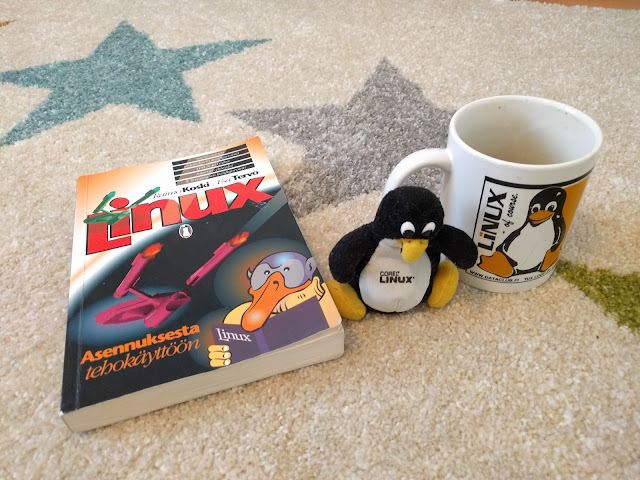
I know very little about hardware.
I think I have a good understanding on many aspects of what happens inside a computer, but my knowledge is clearly firmer on what happens once an operating system is already running. And even then, my understanding of the
lower parts of reality is shaky at most At least according to my self-evaluation, of course, comparing to people I'm honored to call "my peers".
During the last ~18 months, my knowledge of this part of reality, while still far from complete, has increased quite a bit Maybe mostly showing that I'm basically
very cheap: As I have come across very cheap (or even free for me!) hardware, I have tried to understand and shape what happens in levels below those where I dwell.
I have been meaning to do a writeup on the
MIPS Creator CI20, which was shipped to me for free (thanks++!) by
Imagination Technologies; I still want to get more familiar with the board and have better knowledge before reporting on it. Just as a small advance, as this has been keeping me somewhat busy: I got this board after their offer to Debian Developers, and prompted because I'll be teaching some modules on the
Embedded Linux diploma course dictated by
Facultad de Ingenier a, UNAM Again, I'll blog about that later.
My post today follows Riku's, titled
Dystopia of things, where he very clearly finds holes in the
Internet of Things offering of one specific product and one specific company, but allows for generalizations on what we will surely see as
the model. Riku says:
Today, the GPL sources for hub are available - at least the kernel and a patch for busybox. The proper GPL release is still only through written offer. The sources appeared online April this year while Hub has been sold for two years already. Even if I ordered the GPL CD, it's unlikely I could build a modified system with it - too many proprietary bits. The whole GPL was invented by someone who couldn't make a printer do what he wanted. The dystopian today where I have to rewrite the whole stack running on a Linux-based system if I'm not happy what's running there as provided by OEM.
This is not exactly the situation on the boards/products (it's a disservice to call the cute
CuBox-i just a board!) I mention I'm using, but it's neither too far. Being used to the easy x86 world, I am used to bitching on specific hardware that does not get promptly recognized by the Linux kernel But even with the extra work UEFI+SecureBoot introduces, getting the kernel to boot is something we just take for granted. In the MIPS and ARM worlds, this is not so much of a given; I'm still treating the whole SPL and DeviceTree world as a black box, but that's where a lot of the work happens.
The boards I am working on try to make a point they are
Open Hardware. The CI20 is quite impressive in this regard, as not only it has a much more complete set of on-board peripherials than any other, but a
wealth of schematics, datasheets and specifications for the different parts of its components. And, of course, the mere availability of the
MIPSfpga program to universities worldwide is noteworthy Completely outside of my skillset, but looks most interesting.
However... Despite being so much almost-Free-with-a-capital-F, all those boards fail our definitions of freedom in several ways. And yes, they lead us to a situation similar to what Riku describes, to what Stallman feared... To a situation not really better to where we stand on openly closed-source, commodity x86 hardware: Relying on binary blobs and on non-free portions of code to just use our hardware, or at least to use many of the features that would be available to us otherwise.
As an example, both the CI20 and the CuBox-i vendors provide system images able to boot what they describe as a Debian 7 system, based on a 3.0 Linux kernel (which Debian never used; IIRC the CuBox-i site said it was derived from a known-good Android kernel)... Only that it's an image resulting of somebody else installing and configuring it. Why should we trust their image to be sane? Yes, the resulting installation is quite impressive (i.e. the CI20's 3D demos are quite impressive for a system that feels otherwise sluggish, and out of my ARM experience, I'd wager it feels sluggish mostly because of a slow SSD)...
I have managed to do clean Debian installs on most of my ARM machines (the CuBox-i
as described in my previous blog post;
this post from Elena of Valhalla'' prompted me into trying
the already well documented way of running the official Debian Installer, which worked like a charm and gave me a very nice and responsive Debian 8 install Modulo yes, the Banana's non-free video interface, which AFAICT uses the
non-free Mail binary driver... And which I haven't had the time to play with yet. Of course, my CuBox is in a similar situation, where it works like a charm as a personal server, but is completely worthless as a set-top box.
So, with those beautiful, small, cheap SoC systems, we are close to where we stood twenty years ago with x86 Linux: Good support for a small set of peripherials, but a far cry from having a functional system with exclusively free software.
,
Despite claims of being open source, this is not open source hardware. If you are thinking of getting this device, you should also try looking into the hardware from our Community instead.
Still... Playing with these boards has taught me a lot, and has clearly taught me I'm still standing on the first steps of the
n00b level. I have a lot to learn to be able to responsibly teach my part of the diploma course, and I'm very thankful for the differences in hardware (and, of course, for the hardware manufacturers, specially for the MIPS Creator CI20 and the Lemaker Banana Pi for giving me boards to work on!)
I shall keep posting on this topic.
 Today, the animation figure Mickey Mouse finally was released from
the corporate copyright prison, as the 1928 movie
Steamboat
Willie entered the public domain in USA. This movie was the first
public appearance of Mickey Mouse. Sadly the figure is still on
probation, thanks to trademark laws and a the Disney corporations
powerful pack of lawyers, as described in the 2017 article
in "How
Mickey Mouse Evades the Public Domain" from Priceonomics. On the
positive side, the primary driver for repeated extentions of the
duration of copyright has been Disney thanks to Mickey Mouse and the
2028 movie, and as it now in the public domain I hope it will cause
less urge to extend the already unreasonable long copyright
duration.
The first book I published, the 2004 book "Free Culture" by Lawrence Lessig,
published 2015 in
English,
French and Norwegian Bokm l, touch on the story of Disney pushed
for extending the copyright duration in USA. It is a great book
explaining problems with the current copyright regime and why we need
Creative Commons movement, and I strongly recommend everyone to read
it.
This movie (with
IMDB ID tt0019422)
is now available from the Internet Archive. Two copies have been
uploaded so far, one uploaded
2015-11-04
(torrent)
and the other
2023-01-01
(torrent) - see
VLC
bittorrent plugin for streaming the video using the torrent link.
I am very happy to see
the
number of public domain movies increasing. I look forward to
when those are the majority. Perhaps it will reduce the urge of the
copyright industry to control its customers.
A more
comprehensive
list of works entering the public domain in 2024 is available from
the Public Domain Review.
As usual, if you use Bitcoin and want to show your support of my
activities, please send Bitcoin donations to my address
15oWEoG9dUPovwmUL9KWAnYRtNJEkP1u1b.
Today, the animation figure Mickey Mouse finally was released from
the corporate copyright prison, as the 1928 movie
Steamboat
Willie entered the public domain in USA. This movie was the first
public appearance of Mickey Mouse. Sadly the figure is still on
probation, thanks to trademark laws and a the Disney corporations
powerful pack of lawyers, as described in the 2017 article
in "How
Mickey Mouse Evades the Public Domain" from Priceonomics. On the
positive side, the primary driver for repeated extentions of the
duration of copyright has been Disney thanks to Mickey Mouse and the
2028 movie, and as it now in the public domain I hope it will cause
less urge to extend the already unreasonable long copyright
duration.
The first book I published, the 2004 book "Free Culture" by Lawrence Lessig,
published 2015 in
English,
French and Norwegian Bokm l, touch on the story of Disney pushed
for extending the copyright duration in USA. It is a great book
explaining problems with the current copyright regime and why we need
Creative Commons movement, and I strongly recommend everyone to read
it.
This movie (with
IMDB ID tt0019422)
is now available from the Internet Archive. Two copies have been
uploaded so far, one uploaded
2015-11-04
(torrent)
and the other
2023-01-01
(torrent) - see
VLC
bittorrent plugin for streaming the video using the torrent link.
I am very happy to see
the
number of public domain movies increasing. I look forward to
when those are the majority. Perhaps it will reduce the urge of the
copyright industry to control its customers.
A more
comprehensive
list of works entering the public domain in 2024 is available from
the Public Domain Review.
As usual, if you use Bitcoin and want to show your support of my
activities, please send Bitcoin donations to my address
15oWEoG9dUPovwmUL9KWAnYRtNJEkP1u1b.



 If you have to choose one year when you won't fly, this year, 2020, is the one to choose. Why? Because CORSIA. What the heck is CORSIA?
If you have to choose one year when you won't fly, this year, 2020, is the one to choose. Why? Because CORSIA. What the heck is CORSIA?  What does it have to do with *this* Year? The first phase of CORSIA will start next year, so the emissions are frozen to year 2020 levels. Due to certain recent events, lots of flights have already been cancelled - which means the reference year aviation emissions are already a lot less than the aviation industry was expecting. By avoiding flying this year, the aviation emissions are going to be frozen at an even lower level. This will increase cost of co2 offsetting for airlines, and the joke is going to be on them. So consider skipping business travel and taking your holiday trip this year with something else than a plane. Wouldn't recommend a cruise ship, tho...
What does it have to do with *this* Year? The first phase of CORSIA will start next year, so the emissions are frozen to year 2020 levels. Due to certain recent events, lots of flights have already been cancelled - which means the reference year aviation emissions are already a lot less than the aviation industry was expecting. By avoiding flying this year, the aviation emissions are going to be frozen at an even lower level. This will increase cost of co2 offsetting for airlines, and the joke is going to be on them. So consider skipping business travel and taking your holiday trip this year with something else than a plane. Wouldn't recommend a cruise ship, tho...
 Yesterday my contract with my university
Yesterday my contract with my university  My prime interests are academic work, that is research and teaching, where research is in a variety of fields, mostly mathematical logic, theoretical computer science, and formal methods. Recently I am working on an extension of the Curry-Howard correspondence to cover different calculi, in particular Hyper Sequent Calculi, and relate them to some kind of process algebra. For more details see the
My prime interests are academic work, that is research and teaching, where research is in a variety of fields, mostly mathematical logic, theoretical computer science, and formal methods. Recently I am working on an extension of the Curry-Howard correspondence to cover different calculi, in particular Hyper Sequent Calculi, and relate them to some kind of process algebra. For more details see the 

 Well, here are the stats for the final week of the
Well, here are the stats for the final week of the  Pevious articles are here:
Pevious articles are here:  I know very little about hardware.
I think I have a good understanding on many aspects of what happens inside a computer, but my knowledge is clearly firmer on what happens once an operating system is already running. And even then, my understanding of the lower parts of reality is shaky at most At least according to my self-evaluation, of course, comparing to people I'm honored to call "my peers".
During the last ~18 months, my knowledge of this part of reality, while still far from complete, has increased quite a bit Maybe mostly showing that I'm basically very cheap: As I have come across very cheap (or even free for me!) hardware, I have tried to understand and shape what happens in levels below those where I dwell.
I have been meaning to do a writeup on the
I know very little about hardware.
I think I have a good understanding on many aspects of what happens inside a computer, but my knowledge is clearly firmer on what happens once an operating system is already running. And even then, my understanding of the lower parts of reality is shaky at most At least according to my self-evaluation, of course, comparing to people I'm honored to call "my peers".
During the last ~18 months, my knowledge of this part of reality, while still far from complete, has increased quite a bit Maybe mostly showing that I'm basically very cheap: As I have come across very cheap (or even free for me!) hardware, I have tried to understand and shape what happens in levels below those where I dwell.
I have been meaning to do a writeup on the 
 Debian Jessie has been released on April 25th, 2015. This has opened the
Stretch development cycle. Reactions to the idea of making Debian
Debian Jessie has been released on April 25th, 2015. This has opened the
Stretch development cycle. Reactions to the idea of making Debian

 The USB relay is driven with a short script, hard-reset-1
The USB relay is driven with a short script, hard-reset-1